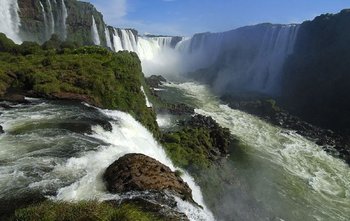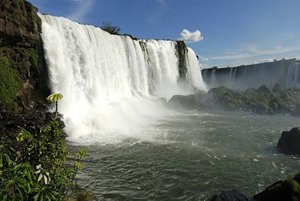Iguassu Falls
|
|

Iguazu Falls are waterfalls of the Iguazu River located on the border of the Brazilian state of Paraná (in the Southern Region) and the Argentine province of Misiones.
The waterfall system consists of about 270 falls along 2.7 kilometres (1.67 miles) of the Iguazu River. Some of the individual falls are up to 82 metres (269 feet) in height, though the majority are about 64 metres (210 feet). The Garganta del Diablo or Devil's Throat (Garganta do Diabo in Portuguese), a U-shaped 150-metre-wide and 700-metre-long (490 by 2300 feet) cliff, is the most impressive of all, and marks the border between Argentina and Brazil. Most of the falls are within Argentine territory, but from the Brazilian side a more panoramic view of the Garganta del Diablo is obtained. Many islands split up the falls, including several large ones. About 900 metres of the 2.7-kilometre length does not have water flowing over it. The first European to find the falls was the Spanish Conquistador Álvar Núñez Cabeza de Vaca, after whom one of the falls in the Argentine side is named.
The falls are shared by the Iguazú National Park (Argentina) and Iguaçu National Park (Brazil). These parks were designated UNESCO World Heritage Sites in 1984 and 1986, respectively.
The name Iguazu comes from the Guarani words y (water) and guasu (big). The legend says that a god pretended to marry a beautiful aborigine named Naipú, who fled with her mortal lover in a canoe. In rage, the god sliced the river creating the waterfalls, condemning the lovers to an eternal fall.
There are two main towns on either side of the falls: Foz do Iguaçu in the Brazilian state of Paraná, and Puerto Iguazú in the Argentine province of Misiones. Other important tourist attractions near the falls include the Itaipu hydroelectric power plant, and the Jesuit Missions of the Guaranis in Argentina, Paraguay and Brazil.
Comparisons to other famous falls

Upon seeing Iguazu, First Lady Eleanor Roosevelt reportedly exclaimed "Poor Niagara!" Vastly larger than North America's Niagara Falls, Iguazu is rivalled only by Southern Africa's Victoria Falls which separates Zambia and Zimbabwe (this is excluding extremely large rapid-like falls such as Livingston de Chutes and Boyoma Falls). Whilst Iguazu is wider because it is split into about 270 discrete falls and large islands, Victoria is the largest curtain of water in the world, at over a mile wide and over 90 metres (300 feet) in height (in low flow it is split into five by islands; in high flow it can be uninterrupted).
The water falling over Iguazu in peak flow has a surface area of about 400,000 square metres (1.3 million square feet) whilst Victoria in peak flow has a surface area of over 550,000 square metres (1.8 million square feet). By comparison, Niagara has a surface area of under 183,000 square metres (600,000 square feet). Victoria's annual peak flow is also greater than Iguazu's annual peak—9.1 million litres per second versus 6.5 million—though in times of extreme flood the two have recorded very similar maximum water discharge (well in excess of 12 million litres per second.). Niagara's annual peak flow is about 2.8 million liters per second, although an all-time peak of 6.8 million has been recorded. Surprisingly, Niagara discharges the most water per year as its water flow does not vary greatly depending on the seasonTemplate:Fact. Iguazu and Victoria fluctuate enormously in their flow rate, and can almost disappear in the dry season. Mist rises between 30 and 150 metres (100 and 500 feet) from Iguazu's Garganta del Diablo, and over 300 metres (1,000 feet) above Victoria (sometimes over 600 metres).
Iguazu, however, affords better views and walkways and its shape allows for spectacular vistas. At one point a person can stand and be surrounded by 260 degrees of waterfalls. The Garganta del Diablo has water pouring into it from three sides, which makes for an exceptional sight. Likewise, because Iguazu is split into many relatively small cataracts, one can view these a portion at a time. Victoria does not allow this, as it is essentially one cataract that falls into a canyon and is too immense to appreciate at once (except from the air). Iguazu and Victoria are generally regarded as the world's most spectacular waterfalls, with people divided as to which is the more impressive.
As of July 24, 2006 a severe drought in South America has caused the river feeding the falls to become parched, reducing the amount of water flowing over the falls to be reduced to 300,000 liters (80,000 gallons) per second, down from the normal flow of 1,300,000 to 1,500,000 liters (350,000 to 400,000 gallons) per second. By early December, the flow was spectacular again, according to visiting tourists.
Iguazu Falls in music
- Tortoise's 1998 album TNT contains a track named "The suspension bridge at Iguazu Falls".
- "Iguazu" is the title of an instrumental song by Gustavo Santaolalla that was featured in the film, The Insider, starring Russell Crowe, the first episode of season 1 of 24, and in the HBO TV series Deadwood. Most recently, it features in the movie Babel, starring Brad Pitt and Cate Blanchet, a film by the Mexican director Alejandro Gonzalez Inarritu, for whom Gustavo Santaolalla has worked before. The song is based mainly on a repetitive fast-picking pattern played on a charango or a similar guitar-like string instrument from Argentina. Beside these soundtracks, it can be found on Gustavo Santaolalla's album Ronroco published on Nonesuch in 1998.
External links
- World Heritage Site (http://www.worldheritagesite.org/sites/iguazu.html)
- Iguazu trip report (http://www.caracara.org/birding/archi00/trip_iguazu.html)
- 28 photos of Iguazu (http://www.imagea.org/photos/southamerica_western_antarctica/br/iguazu/imagepages/image1.htm)
- 360° Panoramic video of Iguazu Falls - requires Quicktime (http://www.worldinmotionvr.com/motionvr_month/2006/march/iguazu_falls.html)
- Cataratas Tourist information (http://www.en.iguazu-cataratas.com.ar)
- Photos of Iguazu Falls (http://www.virtualtravel.ru/user/3778/index.phtml?wid=2167&tips=12)
- View on Google Maps (http://homepage.ntlworld.com/keir.clarke/Iguazu.htm) - includes a short video.
- More facts, maps and pictures (http://www.iguassu-misted-falls-vacation.com/iguassu-falls.html)
- Travelogue and pictures of Iguazu (http://volker.umpfenbach.de/en/reisen/2003suedamerika/2003suedamerika02.htm)
- Iguazu, Argentina side (http://www.travelsaround.eu/eng/argentina/iguazu/index.html)


